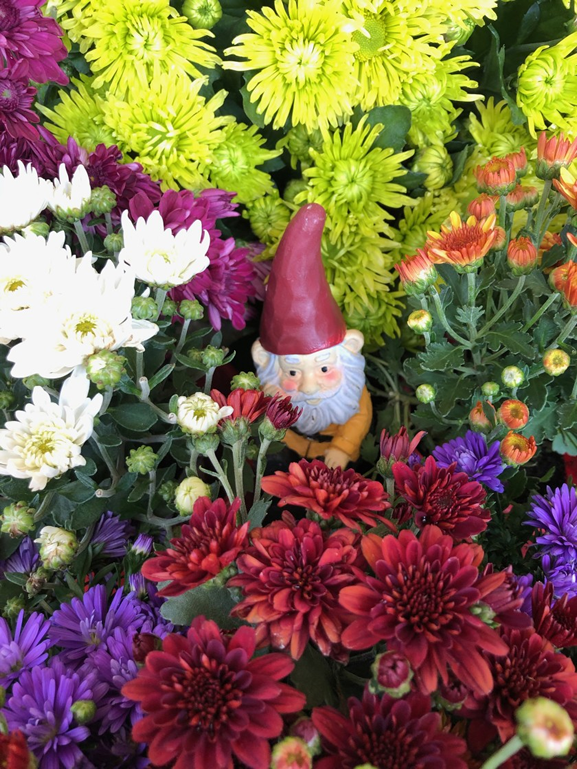Chrysanthemums fill our region with brilliant fall colors

Chrysanthemums grow in a variety of colors and thrive in the fall, when daylight is short and nights are long.(Debbie Handal / UCCE San Diego County Master Gardener)
Our gardening neighbors in the Midwestern, Eastern and Northern states welcome their fall season in predictable ways. The sun rises later in the morning, setting a bit earlier in the evening. Nighttime temperatures begin to dip. Bird species begin their southward migration to warmer climates. The real fall showstopper in these parts of our country is the dazzling display of leaves beginning to change color, from gold to reddish-orange, from crimson to brown.
The Southern California fall season is shorter in duration. Changes to our landscape and gardens arrive slowly, are more subtle and are too soon gone. While we don’t have the display of leaves changing color all around us, we do begin to notice that our garden plants are now beyond their peak, and bloomers have finished flowering.
It’s at this time of year that I wish for just a little something to brighten up my garden landscape. And then I find just what I was wishing for — at the supermarket, of all places! I spot rows of potted chrysanthemums, all wrapped in vivid foil colors. Yes, fall has arrived in Southern California.
These past several months, you may not have been able to travel farther than your local grocery or home improvement store. So, let me invite you to a virtual armchair “historical tour” on chrysanthemums. We’ll travel far and back in time to learn about this flower and plant.
Chrysanthemums, often called by their shortened name “mums,” naturally flower in the fall when days are short and nights are long. With blooms lasting for weeks, mums are easy to grow and come in a variety of sizes and colors. Perhaps you’ve heard of some of them by their common names: pompon, button, spray, cushion, spider and florist’s mums, a special variety bred to have long stems. Did you know that mums also enjoy some interesting symbolic meanings? Depending on which part of the world you come from, the flower can symbolize life and vitality, or death and sorrow.
Chrysanthemums are in the Asteraceae plant family and have a long and interesting history. Originating in Asia, where they were cultivated as a medicinal herb, chrysanthemums were introduced to Japan in the fifth century and are considered a symbol of the country itself. The Japanese call the chrysanthemum “kiku”; the flower blossom is the imperial crest for the Japanese royal family and is the country’s national flower. By the 17th century, the chrysanthemum was brought to Europe. The first flowers seen by Europeans may have been small, yellow and daisylike. Carl Linnaeus, the Swedish botanist, gave the chrysanthemum its Latin name from the Greek words chrysous, meaning “golden,” and anthemon, meaning “flower.”
First introduced to the U.S. during colonial times, the chrysanthemum gained ever-increasing popularity by the late 19th century with garden clubs promoting their special collections of new varieties. Today, gardeners can learn about all chrysanthemum flower types from the National Chrysanthemum Society’sclassification system. The society’s website lists the flowers according to 13 different bloom or petal “forms,” from in-curved, to reflex, single, semi-double, even spoon blossoms that have petals ending with a spoon shape. You’re certain to find a chrysanthemum for every color, scent, texture and shape imaginable. Many botanic gardens (Longwood Gardens, New York Botanical Garden) feature chrysanthemum festivals or exhibits each fall. Behind the scenes, staff gardeners work patiently to cultivate and display a variety of chrysanthemum “forms” by shaping the blossoms into flowering cascades of all types.
In 2018, the UC Master Gardener Program of San Diego County developed a program called “Reminiscence Gardening.” This program is facilitated by Master Gardener volunteers who provide gardening activities at memory care communities across San Diego County and at Alzheimer’s San Diego. Tabletop gardening sensory activities have been created for individuals to touch, feel, see and smell plants of varied colors, scents and textures. With chrysanthemums available in so many varieties, sizes and colors at this time of the year, these flowers are included in many of the “Reminiscence Gardening” sensory activities.
If you plant potted chrysanthemums in the ground this fall and they survive the winter, you can encourage new growth in the spring by pinching back the stems that have new leaves. Pinching is squeezing them between your thumb and forefinger and removing the new stems. You’ll see additional stems branching out, and you’ll have more blooms next fall.
You may have heard the phrase “to plant a garden is to believe in tomorrow.” Gardeners are an optimistic bunch. Here’s hoping that your travel plans for next fall will not be limited to virtual armchair tours. Perhaps you’ll be able to visit a chrysanthemum festival at a botanical garden or take a scenic drive and see the splendor of leaves changing color. In the interim, let’s all be thankful for the potted mums that we find at our neighborhood supermarkets and home improvement stores.
Purcell Montag is a UC Master Gardener who also enjoys travel, history, writing, genealogy and speaking Spanish. Get free gardening advice on the Master Gardener Hotline, (858) 822-6910, or by email at gro.dsrenedragretsamnull@pleh. Due to COVID-19, the Master Gardener Hotline staff members are working remotely to ensure they respond to your questions in a timely manner.

